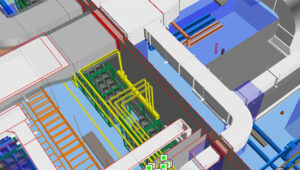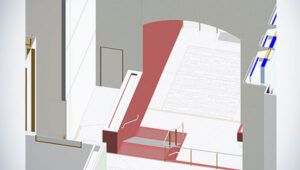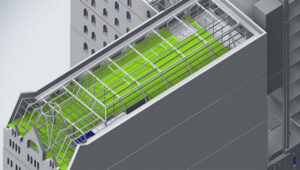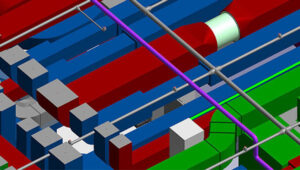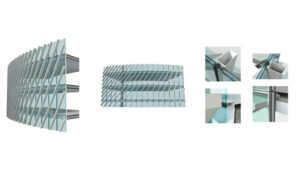The landscape of Electrical BIM Modeling Services is poised for transformative changes, fueled by advancements in technology and evolving industry needs. Let’s explore the dynamic trends set to redefine the efficacy and application of Electrical BIM Modeling.
1. Integration of IoT and BIM in Electrical Design
The integration of the Internet of Things (IoT) with Building Information Modeling (BIM) is revolutionizing electrical design by facilitating the use of connected devices that can send and receive data. This synergy enhances the dynamism and responsiveness of electrical systems within building projects.
- Real-Time Data Acquisition: IoT devices embedded within electrical systems transmit real-time data on system performance and environmental conditions. This data is crucial for making proactive adjustments and ensuring systems operate within optimal parameters.
- Predictive Maintenance: By analyzing data from IoT sensors, BIM software can predict potential system failures before they occur, minimizing downtime and reducing maintenance costs.
- Enhanced Operational Efficiency: IoT integration enables continuous monitoring and fine-tuning of electrical systems, which helps in reducing energy consumption and improving overall efficiency.
Things to Consider:
- Ensure that IoT devices are compatible with the existing BIM software and infrastructure.
- Prioritize security to protect the data and systems from cyber threats.
- Training for team members on the new integrated systems is crucial for maximizing benefits.
2. Enhanced 4D/5D Simulations
4D and 5D simulations represent the natural evolution of BIM by incorporating time and cost dimensions, respectively, into traditional 3D models. These simulations provide a comprehensive view of the project lifecycle, from planning through to execution and maintenance.
- 4D Simulations (Time): These allow for the visualization of the construction process over time, helping project managers to ensure that the project remains on schedule.
- 5D Simulations (Cost): By integrating cost data, 5D simulations help stakeholders understand the financial impact of design decisions and track the budget throughout the project lifecycle.
Tips for Implementing 4D/5D Simulations:
- Start with clear, detailed project plans to enhance the accuracy of simulations.
- Regularly update the simulations to reflect changes and capture the most accurate project timeline and cost projections.
- Use simulations in stakeholder meetings to provide a visual representation of project progress and financial status.
3. Adoption of Digital Twins
Digital twins in BIM create a virtual replica of a building’s electrical systems, which can be used throughout the asset’s lifecycle for various purposes, from design through to operation and maintenance.
- Design Validation: Digital twins allow engineers to test different electrical system configurations to see how they perform under various conditions, ensuring the best possible design is chosen.
- Operational Optimization: During the operational phase, digital twins can simulate responses to different scenarios, helping facility managers optimize the system’s performance.
- Lifecycle Analysis: By simulating wear and tear over time, digital twins can help predict when parts of the electrical system will need maintenance or replacement, aiding in long-term capital planning.
Dos and Don’ts:
- Do: Regularly update the digital twin to reflect changes made during the construction and operational phases.
- Don’t: overlook the importance of data accuracy; the effectiveness of a digital twin depends on the quality of data fed into the BIM models.
4. Increased Emphasis on Sustainability
Sustainability in electrical BIM modeling isn’t just about compliance with environmental regulations—it’s about creating systems that are as efficient as they are responsible. By leveraging BIM’s capabilities, professionals can design electrical systems that minimize energy use and reduce the overall environmental footprint of buildings.
- Energy Efficiency: BIM tools enable detailed modeling of electrical systems, allowing designers to optimize energy use across all building operations. This includes the strategic placement of lighting and the use of energy-efficient fixtures and fittings.
- Resource Management: BIM supports the effective use of materials, reducing waste through precise calculations and specifications. This leads to less surplus materials needing to be manufactured, transported, and ultimately disposed of.
Considerations for Sustainable Electrical BIM Modeling:
- Integrate renewable energy sources like solar panels into your BIM models to explore their impact on energy sustainability.
- Consider the lifecycle impact of materials chosen for electrical installations, aiming for those with lower environmental impacts.
5. Enhanced Prefabrication Techniques
Prefabrication techniques in electrical BIM modeling are transforming the construction industry by shifting much of the assembly process to controlled factory settings before installation on-site. This approach not only speeds up construction but also enhances the quality and precision of electrical systems.
- Speed and Efficiency: By assembling components in a factory, much of the work can be done simultaneously with the onsite building processes, significantly reducing overall project timelines.
- Quality Control: Factory settings provide a controlled environment that minimizes the variables that can affect the installation of electrical systems, leading to higher quality outcomes and fewer defects.
Tips for Effective Prefabrication:
- Use BIM to simulate the assembly process and identify potential issues before production begins.
- Coordinate closely between design and manufacturing teams to ensure that the prefabricated elements integrate seamlessly with other building components.
By focusing on sustainability and leveraging prefabrication, electrical BIM modeling is set to not only meet the current demands of the construction industry but also anticipate future needs, ensuring resilience and relevance in a rapidly evolving market.
Conclusion
At SmartCADD, we are at the forefront of adopting these cutting-edge trends to enhance our Electrical BIM Modeling Services. Our commitment to integrating advanced technologies like AI, IoT, and cloud platforms ensures that we deliver superior quality and innovative solutions to our clients. As we continue to embrace these developments, SmartCADD is dedicated to revolutionizing the AEC industry, driving efficiency, and building smarter, not harder.
FAQS
Using Revit for clash detection offers several benefits, including early clash detection, improved collaboration among project stakeholders, reduced rework and costs, enhanced project coordination, and better overall project outcomes.
AI will revolutionize modeling accuracy, offering predictive analysis for energy consumption, fault detection, and optimizing electrical system design.
BIM facilitates green design strategies, enabling energy-efficient buildings, renewable energy integration, and reducing environmental impact.

